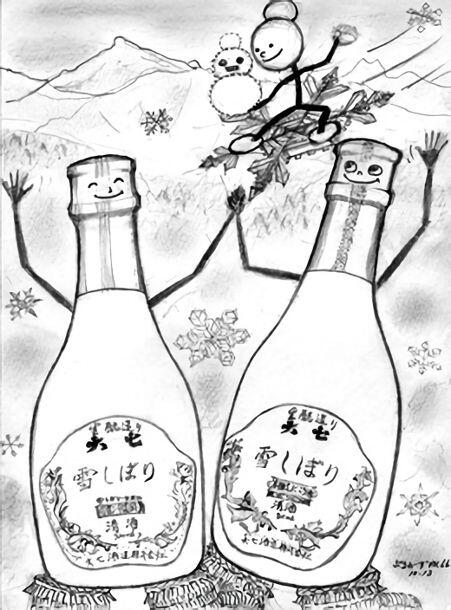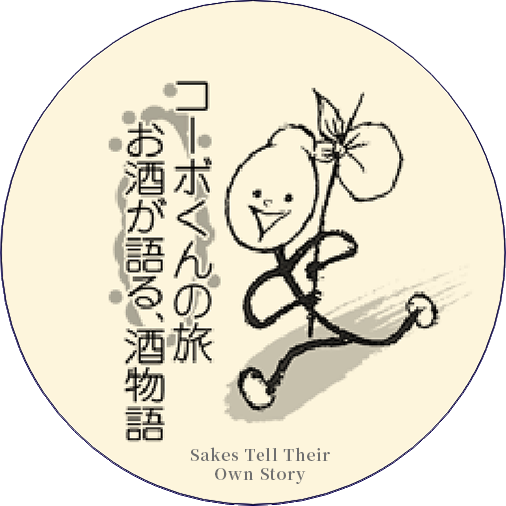| Yeast |
“This time I’m going to visit the Yukishibori brothers, familiar from our seasonal products “Yukishibori Nama-genshu” and “Yukishibori Nigori-zake.” Hello!” |
| The Yukishibori brothers |
“Hi, Yeast!” |
|
 |
| Yeast |
“Are you the elder brother, Nama-genshu?” |
| Nama-genshu |
“Yes. I was born in 1992 and my brother Nigori-zake in 1994. Do you know the origin of our name?” |
| Yeast |
“That is just what I wanted to ask. It’s such a beautiful name.” |
| Nama-genshu |
“We received our name from the famous zymologist, Dr Takeo Koizumi. One day, Dr Koizumi said to Mr Ohta: “I have a present for you!” - and that was our name!” |
| Yeast |
“How stylish, to give a name present!” |
| Nama-genshu |
“The name was based on the image of a sake brewery in Northeastern Japan, which is pressing the sake while outside the snow is falling thick and fast. At that time, Mr Ohta was just thinking about us, so we got that name.” |
| Yeast |
“Yukishibori, ‘Pressed in the Snow,’ is a perfect name.” |
| The Yukishibori brothers |
“Both of us are really fond of that name.” |
| Yeast |
“On what is the design of your labels based?” |
| Nama-genshu |
“The year I was born, 1992, was an important year for Daishichi because it celebrated its 240th anniversary. In that year, also the old grade-based tax assessment system for sake was abolished. Therefore Daishichi decided to change the labels of its regular sake, by starting to use an acanthus leaf as motif. On my bottle sparkles a golden acanthus leaf.” |
| Yeast |
“That means a new Daishichi tradition.” |
| Nama-genshu |
“In the past sake made with the kimoto method always had to be matured for a long time, it was unthinkable to drink it as young and undiluted sake (shiboritate genshu). Daishichi has succeeded in breaking down that technological barrier. I, with my modern table bottle, symbolize the start of a new age.” |
| Yeast |
“The design of Nama-genshu is gold on white, while Nigori-zake has the same design in blue metallic. You were born two years later, weren’t you, Nigori-zake?” |
| Nigori-zake |
“Yes. At that time thick and sweet nigori (‘cloudy’) sake and sparkling sake were popular. Daishichi’s answer was a lightly clouded and fresh nigori sake.” |
| Yeast |
“You became quite popular with your unique light fizz.” |
| Nigori-zake |
“That is because of a second fermentation in the bottle. When the right, fine bubbles have appeared, I am pasteurized to stabilize me. That unique style became all the rage.” |
| Yeast |
“Your quality is always stable because in contrast to other sparkling sakes, you have been pasteurized. There are many people who finally discovered the deliciousness of sake after enjoying Yukishibori Nigori-zake.” |
| Nigori-zake |
“I’m ideally fit as aperitif, as my gentle aroma and slight fizz stimulate the appetite. I fit also to the bittersweet taste of spring vegetables and to tempura. And in the case of Western food, sautés or spicy dishes.” |
| Yeast |
“Delicious! You are also very popular abroad. Nama-genshu, to which dishes do you fit?” |
| Nama-genshu |
“Sashimi, or shellfish and raw mussels, foods which have a fresh taste but which also possess a powerful umami.” |
| Yeast |
“Sounds great! Nama-genshu, you also come out in a version which after pressing has been matured for half a year, as a limited edition “Jukusei Nama-genshu” (matured unpasteurized and undiluted sake).” |
| Nama-genshu |
“By maturing me, the umami and softness increase, and the field of food combinations widens. Such as liver of monkfish (the foie gras of the sea) and meat dishes.” |
| Yeast |
“Thank you very much. Keep up the good work, both of you!” |





